
 |
||||||||||||||
 |
||||||||||||||
I love Brave Last Dave. He volunteered to write this update and nailed it. Thanks, Brave. * * * Consider the sissy. The comic character has been around a very long time. The Astaire-Rogers movies almost always had a sissy, either played by Edward Everett Horton or Eric Blore. (One of the characters Horton played was named Egbert 'Pinky' Fitzgerald, as fine a sissy name as any writer has ever produced.) Peter Lorre goes sissy in The Maltese Falcon. Humphrey Bogart pretends to be a sissy in one scene in The Big Sleep, trying to get information about a fake rare book store that is a front for the bad guys. An interest in the finer things is often a sissy trait, though some sophisticated characters are more fussy than sissy. Clifton Webb in Laura is fussy, as is George Sanders in All About Eve. Jeeves is always fussy, but never sissy. Stephen Fry, an openly gay actor, played Jeeves letter-perfect in the British TV series. Sissy is often a euphemism for gay, but not always. Joe Besser's character Stinky in the Abbott & Costello TV series is definitely a sissy, but he's supposed to be a spoiled kid, and the main comedic drive is seeing a fat, bald, middle-aged guy in a Little Lord Fauntleroy costume. (Besser is also many people's least favorite Stooge. He didn't like getting hit by Moe, and that ruined the "comedy" for many people. Besser was no idiot. Moe Howard did not pull his punches, and Larry Fine's completely asymmetric face in old age is a testament to the damage wrought.) The early days of television were the heyday of the sissy. Louis Nye's character Gordon Hathaway on The Steve Allen Show and Ernie Kovacs as Percy Dovetonsils are archetypical sissies. (Frank Nelson, whose best work is as the bane of Jack Benny's existence with his trademark phrases "Eyeeeeeesssss?" and "Ooooooo, goody!" is more fussy than sissy. Jack Benny was fussy, too.) In the era before cable TV, I can think of four guys whose main work was on TV and played the sissy almost exclusively: Charles Nelson Reilly, Rip Taylor, Paul Lynde and Alan Sues. Many of Sues' obits are claiming he did other things besides being a sissy. He was on Twilight Zone, they mention. I saw it. His role was kind of sissy. He played Moriarty on stage. I didn't see it. Sues' two recurring characters on Laugh-In were Big Al the sportscaster (who rang a little bell) and Uncle Al the Kiddies' Pal, a kid's show host with a drinking problem. Some will argue it was a more innocent time. I would argue it was a more secretive and creepier time. (As further evidence, there was the Buck Henry character on Saturday Night Live who babysat little girls. Jokes about implied child molestation, a deep comic goldmine in the 1970s.) Alan Sues was gay. He was not openly gay. His sexual orientation was made clear by his longtime companion in his obituary. Yes, out of the closet and into the coffin, not the first time we've seen that move and probably not the last. I got a Laugh-In DVD out of the library to do a little research. My best advice is DON'T! I liked it when I was a kid, but it's completely unwatchable now. It gives me an even greater respect for Monty Python because those shows were contemporary and Python is still funny. So we say goodbye to Alan Sues. Sometimes a trip down memory lane is a good chance to figure out how much better things are now. — Brave Last Dave
|
||||||||||||||
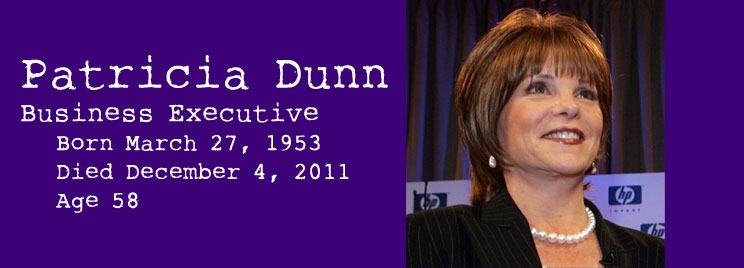 |
||||||||||||||
Wow. I asked for this a couple of hours ago, and look what we get. A perfectly researched and written account of a corporate and personal fiasco. JD Baldwin was clearly the man for the job. (Joke.) * * * Patricia Dunn was on the board at HP when it collectively hired Carly Fiorina in 1999. Dunn was her biggest booster and can fairly be said to have been the "one" who hired Fiorina as HP's CEO. That was not the last huge favor Dunn would do for Fiorina. After about five and a half years of Fiorina's appalling, disastrous, delusions-of-grandeur-driven "leadership" — and as much as I'd like to digress on that point for about six grafs, this update is supposed to be about Dunn — even the jackasses on that company's board realized something had to be done, and they cut her loose. In the grand old "fuck up and move up" tradition of American corporate and government culture (think Robert McNamara almost destroying the Ford Motor Company and then being punished with a cabinet post), everyone conveniently forgot who it was who lobbied hardest to inflict the previous disaster on the company. There was also a good deal of fear about how people would perceive their unceremonious dumping of such a high-profile female executive, so they decided that no one could possibly criticize them on that point if they replaced her with another woman. And so Patricia Dunn became HP's chairman of the board. (HP press release from around that time: "We believe the merger with Compaq will leverage synergies based on our complementary strengths to provide shareholder value by HEY LOOK DID YOU SEE HOW AWESOMELY PROGRESSIVE WE ARE WE HIRED ANOTHER WOMAN!!!!!!!") Dunn wasn't worse than Fiorina. Dunn wasn't even an especially bad chairman at HP, though this time I could go for sixty grafs about the wildly dysfunctional corporate culture at that titan. However, she did have a tragic flaw she shared with her predecessor: a combination of "control freak" personality disorder (whatever the clinical name for it is) and serious paranoia. The paranoia thing may well have been justified. So here's the summary of what happened: the HP board went on a retreat to hammer out a "strategic vision" of where the company should be headed. These kinds of sessions are valuable, as they occupy directors' time and keep them from causing real mischief by actually trying to involve themselves in company operations. One of the directors, Jay Keyworth, discussed the meeting in very general terms with a C|Net journalist, who then published the story based on Keyworth's anonymous summary. The story was complimentary to HP and did not contain any substantive non-obvious information nor, for that matter, any real details about anything. (Sample: "The market is doing this thing that has been really clear to every observer for about three years now. We're going to get more into that, because we think there is money to be made there.") Dunn went apeshit. She hired an outside "security team" and pretty well told them to do what they had to do in order to find the leaker. And that is what they did. Whether they broke any laws in doing so is a fairly open question, but it is not in dispute that they really pushed the envelope, legally speaking, in trying to "social engineer" private information out of people. I mentioned HP's dysfunction earlier, but one thing they really aren't (or weren't back then, anyway) is unethical. When the "spying" came out in the press — and that's how the board learned about it — a couple of the directors who actually had balls[1] stood up to Dunn, and one of them resigned on the spot. I truly believe that they were as outraged by the ethical lapse itself as by the fact that they were the targets of the "spying." [1] In the figurative sense, I hasten to add, no criticism based on the actors' sex intended. This would be when Dunn did Carly Fiorina a much bigger favor than ever before: She served as a scapegoat and lightning rod for all the crap that came up at HP during and immediately after Fiorina's reign. Things went quickly to shit for Dunn, though hardly without Dunn's full cooperation. To begin with, HP filed what could be argued (very convincingly argued, I think) to be a fraudulent SEC filing regarding the board resignations that arose from the scandal. Then Dunn was out, replaced by human canker sore Mark Hurd. (And again I spare you several grafs' digression on the subject of that corporate ass-pimple.) Dunn's ovarian cancer, diagnosed before her ascension to chairman, metastasized into her liver and other places. Then came the criminal charges. Dunn was charged with four felonies in what was mainly a headline-grabbing move by the California Attorney General. The charges were later almost literally laughed out of court — a judge dismissed them "in the interests of justice," which is court-speak for "stop wasting the Court's goddamned time with this bullshit." I'll give Dunn credit: She told the prosecutor to shove it when he offered her a sweetheart plea-bargain: four felonies dropped in exchange for a nolo plea on one misdemeanor. Dunn was an obvious choice for a dead pool, so how the hell did she score as a duet? Her age of 58 plus her elusiveness scored EdV and Mark 17 points — a number coincidentally the same as Dunn's rank on Forbes' list of the most powerful businesswomen when she was chairman. — JD |
||||||||||||||
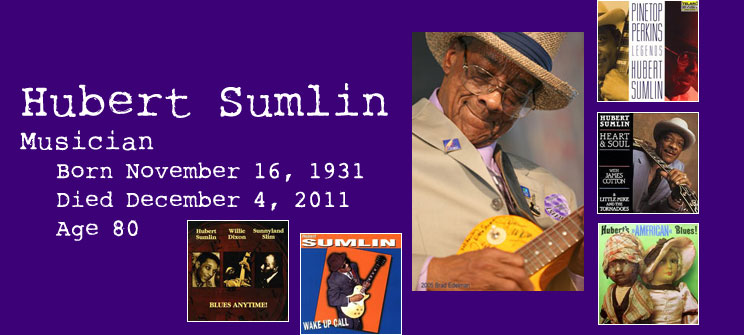 |
||||||||||||||
Lovely update by the other howlin' wolf, Bill Schenley: * * * Hubert Sumlin, the understated guitar player who for many years defined the back of the Howlin' Wolf sound, has died at 80. Sumlin, despite an expansive career that took him from James Cotton to the Rolling Stones, will always be associated with legendary Blues shouter Howlin' Wolf. Sumlin, on some of Wolf's best records, influenced a generation of guitarists: "Back Door Man" (with Otis Spann on piano) was recorded by Robby Krieger and The Doors; "Built for Comfort" by Al Wilson of Canned Heat; and "Goin' Down Slow" ignited the imagination of blues guitarists like Eric Clapton, Michael Bloomfield, Jeff Beck, Duane Allman and Jimmy Page. It was Hubert Sumlin's guitar work (along with Freddie Robinson's) on "Spoonful" that lit a fire under Eric Clapton and Cream. "The Red Rooster" was such an influence on Keith Richards and the Rolling Stones that Richards and Mick Jagger picked up the tab for Sumlin's funeral costs. And, of course, Sumlin's biggest endorsement: Jimi Hendrix's version of "Killing Floor." However, my favorite Hubert Sumlin story is the one portrayed (although not accurately) in the movie "Cadillac Records." Sumlin, tired of Howlin' Wolf's abuse, left his band to join up with Muddy Waters, who also paid Sumlin much more money. Wolf stewed for a few weeks, then went to the club where Waters was playing, threatened to shoot Waters if he didn't give him back his guitar player and, when he got Hubert Sumlin alone, beat the diminutive guitarist senseless. Sumlin later said he waited for Howlin' Wolf to pass out drunk before he took a pool stick to Wolf in retaliation for the beating. Amelia gets a spoonful of points for Hubert Sumlin — five for the hit and five for the solo. Total: 10. Oh, and one other thing. Almost every obituary for Hubert Sumlin pointed out that he was 43rd on the magazine Rolling Stone's list of 100 greatest guitar players. This was not a compliment. Rolling Stone has outlived its shelf life and the magazine should stop publishing such silly lists. — Bill Schenley |
||||||||||||||
 |
||||||||||||||
Brave Last Dave spent his birthday doing this. Give him a hand. * * * 158 titles, it says at imdb.com. That's how many different TV shows and movies Harry Morgan worked on from 1942 to 1999. But he was a regular on so many TV series, that hardly scratches the surface. He was Pete Porter on December Bride. It ran for 155 episodes in the 1950s. Then Morgan stars in the spin-off Pete and Gladys in the early 1960s for another 72 episodes. Slightly younger baby boomers will remember him in as Officer Bill Gannon on Dragnet with Jack Webb from 1967 to 1970 (98 episodes), and only after that does he get what is now his best-known role: on M*A*S*H, as Colonel Sherman Potter, which he reprises on AfterM*A*S*H. With those two together, that 's over 200 more episodes of TV. How many times did this guy hear the words "Action!" and "Cut!"? Conservative estimates put it at about a jillion. He played military and cops a lot. Much of his early career was in westerns, where he often got cast as a bad guy. I don't know why casting directors thought that was a good idea. After a few roles as likable characters, notably as Chummy MacGregor in The Glenn Miller Story, somebody in Hollywood flicked a switch and decided he should be a nice guy for the most part or, at worst, gruff but lovable. Take a good look at that face. You want to like that face. 158 titles is a lot of titles. The best known movies in his c.v. include The Ox-Bow Incident, State Fair, High Noon, The Glenn Miller Story, The Teahouse of the August Moon, Inherit the Wind, How the West Was Won, The Flim-Flam Man, Viva Max, Support Your Local Sheriff!, Support Your Local Gunfighter, two Disney films about the Apple Dumpling Gang, The Shootist and the Dan Aykroyd version of Dragnet, once again playing Captain Bill Gannon. He voices Gannon on an episode of The Simpsons. The most famous historical characters he played were U.S. Grant in How the West Was Won, Harry S. Truman in the mini-series Backstairs at the White House, and Bugs Moran on an episode of The Untouchables. One obit I read said he never went on any talk shows, but imdb.com disagrees. He was on Merv Griffin once. Whether it was one or zero appearances, it's pretty clear that Harry Morgan thought the audience was more interested in Sherman Potter or Bill Gannon or Pete Porter than it was in Harry Morgan. The closest thing to a personal note I'll add is he started his career as Henry Morgan, but changed his name to avoid confusion with the acerbic writer best known on TV as a panelist on To Tell The Truth, I've Got A Secret and What's My Line? I get the feeling Morgan was right. He was a lunch pail kind of actor and it was all about the work. I don't remember any performances that would be used in a master class, but I don't remember any false notes either. I do remember a lot of great movies and shows and I'm glad he was a part of them. Thanks, Mr. Morgan. We'll remember which one you were. Beth&Teresa, Busgal, Chipmunk Roasting, Constant Irritant, Exuma, Fireball, Jenstrikesagain, Kixco, Ray Arthur, The Wiz and Tim J get 2 points apiece. — Brave Last Dave |
||||||||||||||
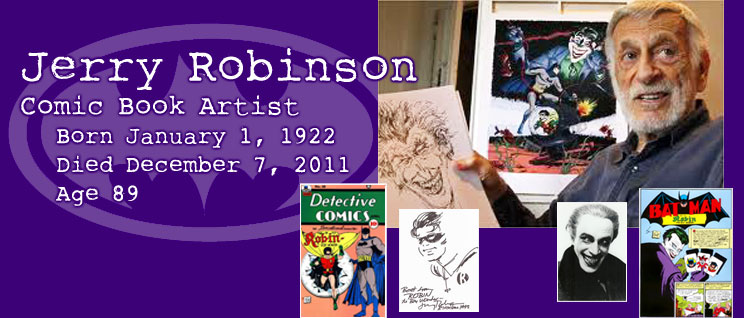 |
||||||||||||||
Brave Last Dave is Kapow! Brave Last Dave is a super-hero!! Brave Last Dave sure knows how to write! * * * Jerry Robinson's main claim to fame, the creation of The Joker, is disputed by Bob Kane, the guy everybody agrees invented Batman. Kane says all Robinson did was suggest that the Joker use a playing card as his calling card. There is a consensus that it was writer Bill Finger who saw the 1928 German silent movie The Man Who Laughs and said the character looked like Conrad Veidt. (No one who played the Joker is half as scary as Veidt in that make-up, shown in the small black and white photo above. You need to keep that crazy smile fixed on your face to make the Joker truly menacing.) In any case, comic book historians have come down on Robinson's side. He also takes credit for coming up with the name "Robin" for Batman's sidekick, from Robin Hood. It is generally agreed now that Robin was a mistake in the Batman story, an attempt to humanize him. Modern versions of Batman are dead set against humanizing him. Robinson also claims to have come up with Alfred, Bruce Wayne's butler. Unlike Robin, Alfred is a great idea. There is no version of Batman I am aware of that does not have his Alfred, the Greek chorus of disapproval and loyal service. So if we take Robinson at his word (and why the hell not?) he's batting .667, which keeps you in the big leagues no matter what trade you ply. Born with the Defect, the hardest working man in show business, gets the delicious solo. Ten points. 5 + 5. — Brave Last Dave |
||||||||||||||
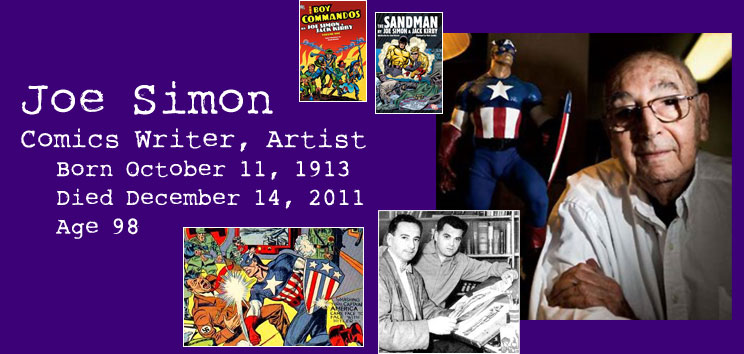 |
||||||||||||||
During the late 1930s, there was this bunch of smart kids, mostly Jewish, mostly around 19 years of age, and mostly living in and around New York City. They saw that the world was falling apart and that America was doing little or nothing about it, so they began moving in with each other and forming little collectives dedicated to writing and, in some cases, drawing. Some of these kids wrote science fiction for pulp magazines, and a small fraction of it remains in print even to this day. You may even have heard of some of the writers; Asimov was one. That's fine — but the broadest and longest-lasting fame came from the comics, which were pulps with lots of color pictures. (If you want to know more about all of this, and how things really were, pick up a copy of Michael Chabon's excellent novel The Amazing Adventures of Kavalier and Clay. We live in a world where you can win the Pulitzer for fiction for a book about comic-book creators, and you can pick up an Oscar for playing the Joker. That's cool.) Most famously, Joe Simon and his creative partner, Jack Kirby, created Captain America for Timely (later Marvel) Comics. Cap was the staunchly WASP champion who showed his readers the evils of the world of 1940 and how best to fight them. Joe and Jack did their best to persuade generally isolationist America that the only way to deal with the monsters ruling Europe was to go over there and root them out. That was a cold, hard, uncomfortable truth, but committed youth has always spoken truth to power. A few months after Captain America's debut, the Sentinels of Liberty feature from Cap's comic was spun off into its own book and retitled Young Allies, which was about a group of half a dozen kids who fought whichever dictator Cap wasn't busy fighting that month. Much has been made of the punch Captain America lands on Hitler's jaw on the cover of Captain America #1 (March 1941), which depicts Cap interrupting a plan to invade and subdue the U.S. There are maps and papers all over Hitler's desk, and there's a document marked SABOTAGE PLANS FOR U.S.A. Hitler also has a big-screen TV on which, somehow, he's been watching a live broadcast of a Nazi agent blowing up an American munitions plant. Cap wades into all of this stuff and throws a solid all-American punch. That issue was on the stands about a year before Pearl Harbor brought America directly into the war, and it sold almost a million copies. Young Allies debuted a few months later with a cover showing Cap's teenaged sidekick, Bucky Barnes, punching Nazi master spy The Red Skull, who then crashes into Hitler. That one sold more than a million. Joe and Jack stayed with Timely for only ten issues of Captain America. Joe realized that Timely was cheating the two of them out of their share of Cap and the Allies' considerable profits, so they went to National (later DC) Comics. Joe and Jack dabbled with tweaking other peoples' creations before coming up with the Boy Commandos and the Newsboy Legion — separate groups of spunky teens fighting Hitler, Mussolini, Tojo and all the rest, at home and away. Both teams were big hits; in fact, the Boy Commandos title sold more than a million copies per month and was National's third best-selling title, after Action Comics and Superman. Joe joined the Coast Guard during the war and, after his discharge, married Harriet, who was secretary to the guy who ran Harvey Comics. Joe and Harriet moved into a house in Mineola, Long Island, that was catty-corner from Jack and Roz Kirby's. Joe and Jack (who'd been in the Army) resumed their partnership, working in their own studio and freelancing for Harvey and several long-forgotten publishers. They scored a big one when they created the category of romance comics for Crestwood Publications. Somehow nobody had ever thought of romance comics before, even though there were scores of romance pulp magazines in various shades of blue. Joe and Jack's partnership lasted until 1956, when they appear to have gotten bored working together, and Joe had gotten tired of being screwed out of serious money by their publishers. Joe wanted a "real job" and went to work in advertising, although he'd still drop a script on a comics publisher now and then. He even got back together with Jack Kirby for work on a clutch of superhero characters Archie Comics was launching in 1959, and they paired again in 1966 for a one-shot for Harvey Comics featuring an update of Fighting American, the duo's own Cold War knock-off of Captain America. Joe and Jack teamed up for the last time in 1974, when they tried a relaunch of the Sandman for DC. By then, Joe had plunged headlong back into comics, editing DC's romance titles and creating or co-creating the bizarre Brother Power the Geek and Prez, the first teenaged U.S. president. Many of Joe Simon's creations, with and without Jack Kirby, remain well-remembered. For instance, Prez showed up at the end of a recent Batman: The Brave and the Bold episode. Marvel published a touching, present-day coda for the Young Allies in 2009. Captain America, of course, is still with us, even though they killed him off a few years ago. (They always come back, you know.) The Wiz scored a neat solo with Joe Simon and picked up seven points: two for age and five for the solo. — Brad |
||||||||||||||
 |
||||||||||||||
Classic Schenley. * * * In the second inning of game five of the 1956 World Series, the Brooklyn Dodgers' Jackie Robinson hit a line shot at New York Yankee third baseman Andy Carey. The ball sliced off Carey's glove and bounced directly into the hands of the Bombers' shortstop, Gil McDougald, who just got Robinson at first. In the eighth inning, the Dodgers' Gil Hodges sent another line drive at Carey, and this time the Yankee third sacker held on to the ball. An inning later, Don Larsen had pitched the first and only perfect game in World Series history. With Andy Carey's death, only two men who played in that game are still alive: Don Larsen and Yogi Berra. [1] Carey, who at one time was married to actress Wendy Marlow, played for the Yankees on two World Series championship teams, 1956 and 1958. His best season was probably 1958, when he hit .286 with 12 home runs and 45 runs batted in. The Yankees traded Carey to the Kansas City Athletics as soon as Clete Boyer was ready to be an everyday player. Then came the last game to be played at the old Yankee Stadium: September 21st 2008. Andy Pettitte started the game, José Molina hit the last home run, Mo made the last pitch, Jeter was the final Yankee to bat ... but before all that happened, the Yankees introduced as many living former Yankees as they could pry from the Grim Reaper's moldy, old hands. Andy Carey was among the living, but just by a moment. As they wheeled him onto the field, wearing an oversized #6 jersey, a cap four or five sizes too large ... and his oxygen tank, I swear I heard him wheeze the words, as he looked up at the kid pushing the wheelchair, "I think I just shit myself what's for dinner." I may have the last few words wrong because I was already out of the room screaming, "Where's my deadpool list for next year?" My daughter cried out, "But, dad, he's a Yankee." "Fuck the Yankees," I shouted back. "He's a dead man." Took a few years, but Andy Carey is a dead man. I not only get five points for the hit, and five bonus points for the solo, but I also get an additional ten points for hitting the Daily Double (with Christopher Hitchens). Total: 20. — Bill Schenley [1] These are the Yankees and Dodgers who are still alive and who were in uniform that day, but did not play in the game: |
||||||||||||||
 |
||||||||||||||
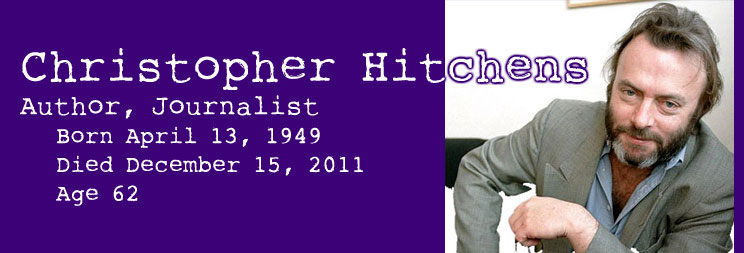 |
||||||||||||||
Christopher Hitchens was one of the most eloquent and erudite men of his time. His essays for Vanity Fair (and for various English newspapers) showcased his exquisite prose, while his many television and radio appearances showed the man in his element: incisive, quick-minded, and silver-tongued in that rumpled academic way only an Englishman can successfully pull off. His fans lapped it up: He was everything they wanted him to be, and everything they wanted one day to be themselves. Too bad he was completely full of shit. No, seriously: Most of what he stood for, most of what he argued for was either inarguable — a matter of personal opinion that no amount of words, no matter how eloquently expressed, can quantify or factualize — or just plain wrong. He was one of the most strident voices supporting the Bush administration's claim that Iraq had WMDs. He once wrote that the US's main intention towards Canada during the Cold War was annexation, which has to be the single most ignorant thing I've ever read in an English newspaper (and I've read the Daily Mail) — the personal aspect aside, can you imagine the propaganda boon that annexation would have created for the Soviets, especially given the longstanding American protests over the Soviet annexation of the Baltic states? Further examples abound: His debate with Tony Blair over religious belief — something that can't be reduced to mere logic no matter how much Hitchens wanted it to — was about as sensible as a debate over the taste of vanilla. So why did so many people unthinkingly follow him? One reason is the common fallacy that eloquence equals accuracy, but for the most part I think it comes down to the Silverback Effect: the idea that someone who displays traits you find personally attractive (and especially traits you'd like to see yourself as having some day) can Do No Wrong. Hitchens was the epitome of the cool, intelligent, incisive, sophisticated well-spoken Englishman, a Hugh Grant character writ large and in real life. He wasn't afraid to say what he meant; he prided himself on his blunt demeanor, which was interpreted by his fans as "honesty" and "forthrightness." In short, he was the Silverback. But you know, the Silverback is usually as full of shit as the rest of us. One thing I did like about Christopher Hitchens was his disdain for eulogistic obituaries, so he didn't get one here. 15 hits: Allen Kirshner, Amelia, Bill Schenley, Born with the Defect, Charlene, Chipmunk Roasting, Denise, EdV, Erik, Hulka, Loki, Mark, Monarc, Morris the Cat and Tim J. 11 points each. — Charlene |
||||||||||||||
 |
||||||||||||||
You may be asking yourself, why is Charlene writing an update about a New Zealand auto racer? What does she know about a sport that doesn't involve ice, skates, guys named Dustin and Wade, and loud assholes in louder suits? And you'd be right, too: Before I searched Google News for "terminally ill" last December, I didn't even know that there was such a thing as touring car racing, let alone that they did it in Australia, let alone that Jason Richards was a driver. But he was, and if the copious obituaries coming out of New Zealand for the man are correct, he was a star. More importantly, though, he was just this guy, living his life just like the rest of us, with a young family to take care of and all the worries and concerns that anyone in that situation would have, and WHOOMP he gets this diagnosis slammed into his face out of nowhere: adrenocortical carcinoma, cause unknown, prognosis terminal. Who the fuck asks for that? But this is the measure of the man: Four months after receiving this horrible diagnosis, after learning that he wasn't going to see his kids grow up, after realizing that he was facing the end of everything and the loss of everyone he loved, Jason Richards came in second in the Australian Grand Prix non-Championship event. Most of us would have been off whimpering in the corner; he was, as he said, just having fun. Jason Richards died on December 15 at the too-damned-early age of 35. It was a solo for me, Charlene: 20 points for his age plus five for the solo = 25 points. — Charlene |
||||||||||||||
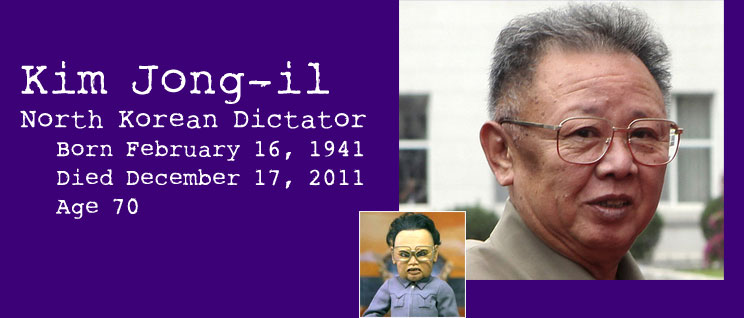 |
||||||||||||||
Short and brilliant. Not easy to do. Thanks, Charlene. * * * Hannah Arendt's theory of the banality of evil isn't just a pithy catchphrase. Evil usually is boring, commonplace, the result of average people doing average things for the wrong reason. But nobody really wants to believe that; it's too close to admitting that we ourselves are capable of evil. We're much more comfortable if evil is either glamorous — and therefore a sign of moral decadence — or ridiculous — and therefore a sign of mental illness. No points for knowing where Kim Jong-il fits into that equation. He was the buffoon, the idiot, the goofy weirdo photographed looking at things, the numbskull liar who claimed to be the Korean Jesus and Tiger Woods all rolled into one. But that ridicule ignores the reality of Kim Jong-il's rule: the millions dead from deliberate starvation, the millions more permanently disabled by malnutrition, the thousands "purged" for showing intelligence or initiative, the lives shattered, the families torn apart, the nuclear weapons pointed God knows where with the red button directly under his finger. This guy was a micro-Stalin, a monster almost beyond words whose Holodomor was directed against his own people. It's impossible to know if the world would have been better had Kim Jong-il never been born, but if there was ever a candidate for retroactive abortion, this bastard would have been it. I don't usually believe in Hell, but for him I would make an exception. I salute ???Guest, Abby, Allen Kirshner, Allezblancs, Another Lurker, Buford, Dead Batteries, Deepstblu, Denise, DGH, Eternity Tours, Fireball, Hulka, Jazz Vulture, JTH, Kathi, Loki, Mo, Moldy Oldies, Ray Arthur, Sarndra, Tim J, Walking Dead Dude and Worm Farmer, who had him in their deadpool and who richly deserve the 8 points each of them receive. It's more than most of his victims ever got. — Charlene |
||||||||||||||
 |
||||||||||||||
Charlene comes through again. I've run out of wonderful things to say about her. * * * In his 1978 essay "Power of the Powerless," playwright and poet Václav Havel wrote that the success of authoritarianism is guaranteed not by any Big Lie handed down from above, but by an intricate network of self-preserving Little Lies that bubble up from below. Communist ideology, he theorized, forces people to live within the network of lies and to combat the cognitive dissonance this creates with catch phrases and slogans designed to make the decision more palatable. His example is that of a greengrocer who knows that if he doesn't place a worker's rights poster prominently in his window he'll suffer repression. The poster's overt meaning, trite and uncontroversial, allows the grocer to ignore its unsaid meaning of "I am afraid and cannot disobey" in order to preserve his dignity, but it also ensures that the only ones who can dissent are those whose dedication to the truth — the only power the powerless hold — is so strong that they're willing to suffer the catastrophic consequences of honesty. For that one, Havel received five years in prison. The authorities might have wanted to silence Václav Havel, but he was too well-known in the West and his works too widely distributed and respected for any disappearance or "accident" not to spark a major international furore. So they threw him in jail, they banned his plays, they burned his books, they threatened his wife. But Havel refused to set aside his own dedication to the truth, and ten years after he was imprisoned for "Power of the Powerless" he was elected President of Czechoslovakia. He later became president of the Human Rights Foundation, joined the Green Party, and became a member of the European Council on Tolerance and Reconciliation. He never stopped writing, though; his last full-length play, the 2007 "Leaving," was produced to standing ovations in May of the following year. Vacláv Havel was 75 years old when he died on December 18 in the town of Vlcice in the northern Czech Republic. To the end he spoke to the truth of democracy, human rights, and ecological responsibility. Our Pat Peeve was the only deadpooler to speak to the truth of his death, and consequently receives eight points plus five for the solo. Total: 13. — Charlene |
||||||||||||||
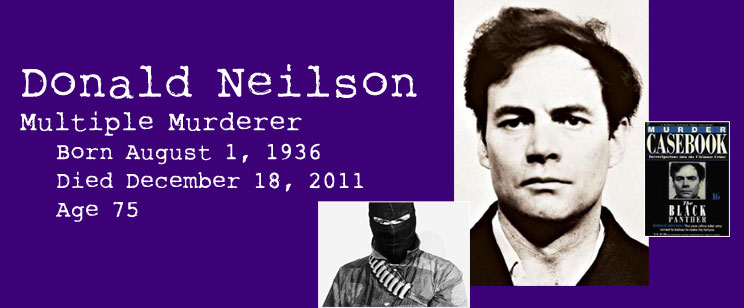 |
||||||||||||||
Grateful am I that our DDT wrote this. Wonderful writing, but what a gruesome tale, about which I knew nothing. DDT and Mo get 11 points each: 8 for the hit and 3 for the duet. * * * Donald Neilson was convicted of the murder of four people, and was one of the few in Britain to have been told by a judge that he should spend the rest of his life in prison with no hope of parole. He was most notorious for the murder of 17-year-old Lesley Whittle, whose kidnap and eventual death dominated the British press for weeks in early 1975. Such was the horrific nature of Whittle's death, it is easy to overlook the fact that, as well as being a kidnapper, Neilson was also a violent burglar and robber. His three other murder victims were all post office employees, shot to death when they were unfortunate enough to encounter Neilson at their place of work. Neilson, from Bradford in Yorkshire, turned to crime when the business he had acquired after leaving the army failed. He became a prolific house burglar before graduating to carrying out armed robberies on post offices, not hesitating to use his gun if he ever ran into difficulties. He picked up a nickname of "The Black Panther" due to witnesses at Neilson's numerous crime scenes reporting sightings of a prowling figure dressed all in black. Although his post office robberies proved to be much more lucrative, Neilson hoped to make even larger sums of money through other means, and began to make meticulous plans for a kidnap. Lesley Whittle was targeted by Neilson after he had read about her inheriting a sum of money from her father. He broke into the Whittle family home and gagged and bound Lesley before dragging her out of the property, leaving behind a ransom note. Neilson kept the terrified teenager captive on a tiny ledge deep underground in a drainage shaft. She was stripped naked, a hood was placed over her head, and she was tethered by the neck to the side of the shaft. In the days that followed, Neilson unsuccessfully attempted to collect the £50,000 ransom he had demanded from Lesley's relatives. He forced Lesley to record messages on a tape recorder, instructing her family where they should leave the money. There were two botched attempts at dropping off a suitcase full of cash to Neilson. Either Neilson's instructions were not accurately adhered to, or he was spooked into believing he would be caught and arrested. At one point Lesley's brother Ronald, who was trying to deliver the ransom, came within yards of the drainage shaft where his sister — still alive at this point — was held. After these failed attempts to collect the money, Nielson made no further contact with the Whittle family. Only Neilson himself knew what happened to Lesley Whittle next and, until he died, he never revealed the truth about this to anyone. There is one theory that Neilson, furious that he had not succeeded in collecting the ransom, caused Lesley's death by kicking her, still tethered by the neck, off the side of the ledge. Eight weeks after her disappearance, her hanging body was finally discovered. A post-mortem examination revealed her stomach and bowel to be completely empty, which led to speculation that Neilson had abandoned her after his failure to collect the ransom, leaving her still hooded and unable to see, to slowly starve for days or weeks before she eventually slipped to her death from the ledge. Forensic evidence linked the perpetrator of the "Black Panther" robberies and murders to Lesley Whittle's kidnap. Neilson was eventually apprehended, eleven months after the kidnap, following a violent struggle with two police officers whom he had threatened with a shotgun when they approached him after he was seen acting in a suspicious manner. Neilson pleaded not guilty to all four murders at his 1976 trial; his defence team argued that all of the post office employees were shot "by accident," and that Whittle had caused her own death by slipping from the ledge where she was confined. He was quickly found guilty on all four counts and sentenced to life in prison. He would have been convicted of a fifth murder as well; however, this victim, another post office employee, died more than a year and a day after sustaining his gunshot injuries, meaning that under a 700-year-old British law (finally abolished in 1996), Neilson couldn't be accused of causing his death. In 2008 Neilson, now suffering from motor neurone disease, appealed to be released from prison, claiming that his whole-life tariff was unlawful. He received no public support and was told in no uncertain terms that he would remain in prison until he died. A journalist who visited the elderly lifers wing at Norwich Prison in 2009 described Neilson as a pathetic figure, now wheelchair-bound and almost completely paralysed, trying in vain to paint, using a brush held in his mouth. His death, announced just before Christmas, was treated almost universally in the UK as a good-news story. During his thirty-six years in captivity, Neilson was not known to have ever expressed any remorse for his crimes. — DDT |
||||||||||||||
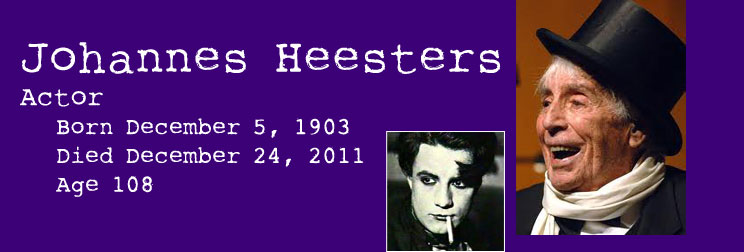 |
||||||||||||||
With all due respect to the other fine writers here at the AO Deadpool, Charlene is in a class all by herself. Thanks, C. * * * Ever been to Dachau? If he were still alive, you could ask Johannes Heesters all about it. He was there: Oh, not after the war like the pilgrims who pay tribute to the thousands brutally butchered by the Nazis, and not during the war to provide succor to his fellow citizens incarcerated there. No, Johannes Heesters was there to perform for the SS. This wouldn't be a huge scandal had Johannes Heesters been born a German. We might not condone a German actor performing for the SS, but at least we can understand patriotism and devotion to one's country. But Johannes Heesters was Dutch: Born in Amersfoort, near Utrecht, Heesters moved to Austria as a young man, appearing on the Viennese stage for the first time at age 31 in Carl Millöcker's "The Beggar Student." A year later, in 1935, or two years after the Nazis took over, he moved to Germany and continued his career there. Although it's true that there's no evidence of Heesters being involved in the production of propaganda, his frequent claims of "just being an actor" have to be balanced against evidence showing that he donated part of his earnings to the German military-industrial complex, knew of the concentration camps, and was friends with many high-ranking officials. He was the only non-German to appear on the Gottbegnadeten List, the list of artists considered essential to the Nazi regime. He recently took author Volker Kuehn to court for stating that he'd played to SS officers. He lost the case, but the judge stated that he had doubts that the memory of survivor Viktor Matejka, who testified that he pulled the curtain for Heesters, could be relied on after fifty years. Me, I think that if you're a concentration camp inmate and the most famous actor in the country waltzes by, you remember it. Reading between the lines, Heesters comes across not as evil per se but as monumentally stupid. He once said on Dutch TV that Hitler was "a good guy," then expressed shock that the program broadcast that clip and not one in which he said the Nazi regime was evil. "What have I done?" he asked. I don't know, Johannes: Why don't you ask Oskar Schindler, Freya von Moltke and Albert Göring what you could have done? Johannes Heesters died in Germany on December 24 at the age of 108. The good die young for The Wiz, who gets one measly point plus five for the solo. Total: 6. — Charlene |
||||||||||||||
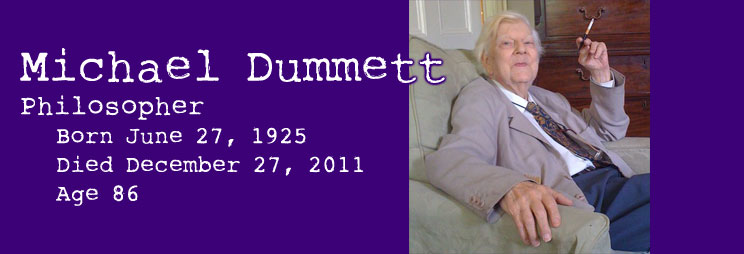 |
||||||||||||||
A lovely update by DDT on a subject that's not easy to write about. Thanks awfully. Andrew McKie gets 5 for hit. 5 for the solo. 10 for end-of-year bonus. Total: 20! * * * It is said that some philosophers die frustrated that they haven't managed to adequately articulate their particular philosophical point of view during their lifetime. This certainly wasn't the case with the mercurial Professor Sir Michael Dummett, who remarked upon his retirement that he was "very happy" with his body of work. Although hardly a household name, Professor Dummett is thought of by many to have been one of the most influential philosophers of the last century and was one of Oxford University's most revered academics. Professor Dummett's fearsome intellect was focussed on the analytical study of language, truth and falsehood. I can't pretend to understand the finer points of the Dummettian school of thought; in fact, I struggle to even comprehend the basics. What I do know is that he was much loved by his students for his passionate delivery and the ease with which he was able to deliver lectures on often mind-bogglingly complex philosophical concepts. Professor Dummett was considered not only to show humanity as a thinker, but as a person: He was a passionate anti-racist and an advocate for the rights of immigrants. In addition to his academic endeavours, he also found the time to become a leading expert and author on the subject of tarot card games. Born in London in 1925, the young Michael Dummett excelled at school and was offered a scholarship to Christ Church College at the Oxford University. Before he commenced his studies, Dummett was enlisted with the British Army. During World War II he was stationed in India and Malaysia serving with, rather aptly, the Intelligence Corps. In 1950 he graduated with a first class honours degree in Politics, Philosophy and Economics. He was offered a fellowship to stay at Oxford and remained there for the rest of his academic career, which culminated in his elevation to the post of Wykeham Professor of Logic and a knighthood for services to philosophy. Professor Dummett was uncompromising in his own beliefs, but was more than happy to debate the pros and cons of his convictions for hours at a time with anyone brave enough to debate with him. He was renowned for occasionally staying up all night with a bottle of whisky, a typewriter and two packets of cigarettes, churning out page upon page of intense analytical theory. These nocturnal sessions resulted in numerous books; he published weighty tomes on language, metaphysics, mathematics, thought, intuition and reality. He also became the world's most renowned authority on the German philosopher Gottilob Frege; three of his books were devoted entirely to Frege's work. Professor Dummett was, by his own admission, devastated when he found out that Frege, whom he had always admired, was in fact a virulent racist and anti-Semite. Professor Dummett was shocked by the discrimination he had witnessed in India during the war and spent the rest of his life campaigning against racism and promoting civil rights for minority groups. He was appalled at what he perceived to be Britain's lack of compassion for refugees, particularly those from Africa, and was firmly of the belief that all countries had an absolute duty to protect those fleeing persecution. He frequently turned up at airports to plead on the behalf of hapless detained foreign nationals, and was on one occasion arrested due to his protests, although he was later released with an official apology. Professor Dummett was an avid chain smoker; his hair was described as being stained yellow at the front due to this habit. He was warmly remembered by his students for his good sense of humour, raucous laugh and twinkling eyes that could barely be made out through the haze of cigarette smoke which almost always surrounded him. A devout convert to the Roman Catholic church, Professor Dummett is survived by his wife Mary, who was also an active campaigner against discrimination. Together they had seven children, two of whom predeceased him. — DDT |
||||||||||||||
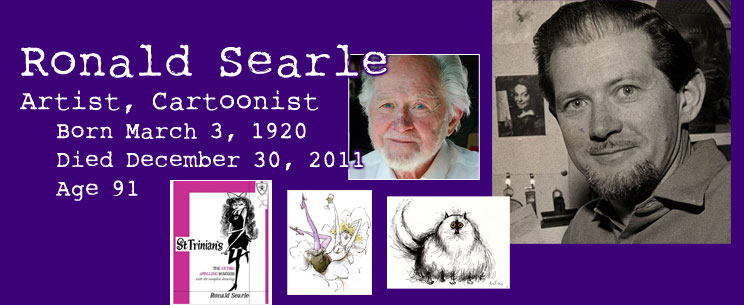 |
||||||||||||||
My favorite possession when I was a little girl was a book of Punch cartoons, given to me by a very astute grownup, and which I think may actually have been published in America. The cartoons were very English, though, and made me an Anglophile while I was still playing with my Barbie doll. I look at the book today and I can remember laughing at those illustrations the first time around. I don't recall having any trouble understanding them. "It says here the East Wing burned down last night." "And since you are the 499,999th visitor to the Festival Year Show, we should like you to accept ... " I'll bet you can understand how thrilled I was to be in on the joke. Cartoonist Ronald Searle was in on the joke, as well. Searle was traditionally English in graphic expression, but his appeal was universal. He wasn't in that Punch book I have, as I think he arrived at Punch a little later than this book, but I remember him from the New Yorker and TV Guide covers. He touch was light as a feather, he had a soft spot for cats, and he designed title sequences for silly movies, like Those Magnificent Men in Their Flying Machines. He created that absurd girls' school, St. Trinian's. His illustrations seemed to float in air. And yet, his was a triumph of the human spirit, because his was a very bad war, spent as a POW forced into labor building the Burma railway. I will forever be thankful for the English making sure there were war artists at home and abroad. For Ronald Searle was a very fine war artist. Hundreds of thousands of those POWs died. Ronald Searle lived to tell their tales. And a few of his own. Searle was our last hit of the year, and he lived long enough to give Buford his bonus. Just 2 points for the hit, 5 for the solo, but 10 for the end-of-year bonus. Total: 17. — Amelia |
||||||||||||||
